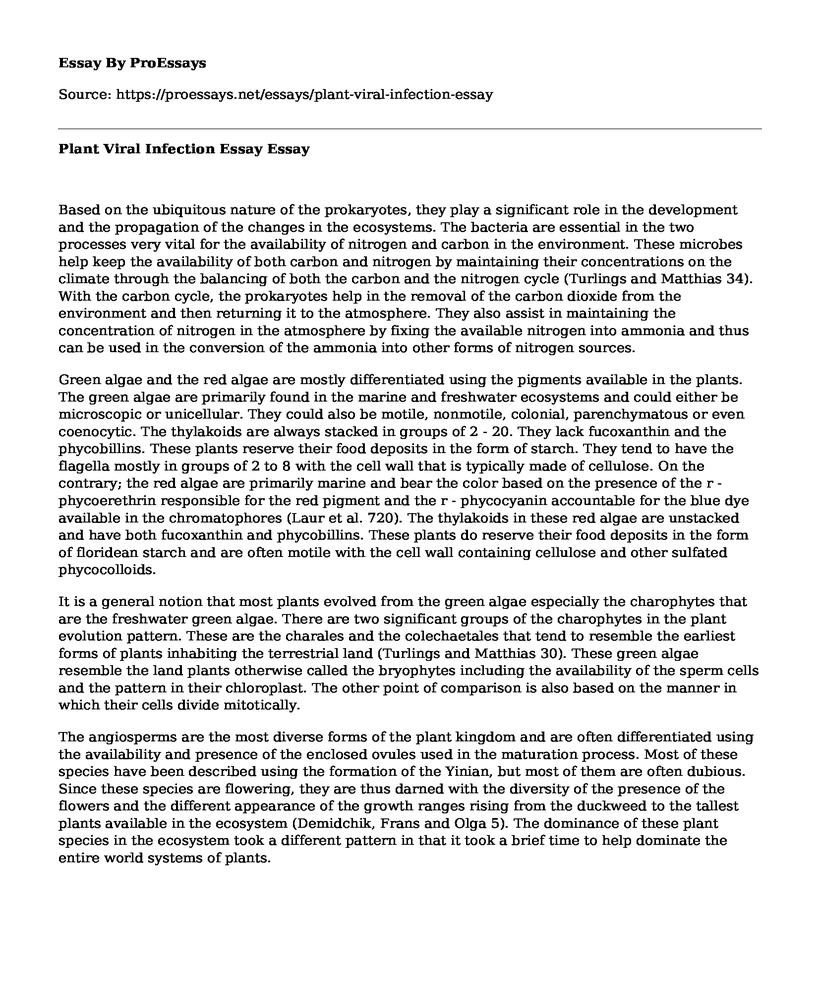Based on the ubiquitous nature of the prokaryotes, they play a significant role in the development and the propagation of the changes in the ecosystems. The bacteria are essential in the two processes very vital for the availability of nitrogen and carbon in the environment. These microbes help keep the availability of both carbon and nitrogen by maintaining their concentrations on the climate through the balancing of both the carbon and the nitrogen cycle (Turlings and Matthias 34). With the carbon cycle, the prokaryotes help in the removal of the carbon dioxide from the environment and then returning it to the atmosphere. They also assist in maintaining the concentration of nitrogen in the atmosphere by fixing the available nitrogen into ammonia and thus can be used in the conversion of the ammonia into other forms of nitrogen sources.
Green algae and the red algae are mostly differentiated using the pigments available in the plants. The green algae are primarily found in the marine and freshwater ecosystems and could either be microscopic or unicellular. They could also be motile, nonmotile, colonial, parenchymatous or even coenocytic. The thylakoids are always stacked in groups of 2 - 20. They lack fucoxanthin and the phycobillins. These plants reserve their food deposits in the form of starch. They tend to have the flagella mostly in groups of 2 to 8 with the cell wall that is typically made of cellulose. On the contrary; the red algae are primarily marine and bear the color based on the presence of the r - phycoerethrin responsible for the red pigment and the r - phycocyanin accountable for the blue dye available in the chromatophores (Laur et al. 720). The thylakoids in these red algae are unstacked and have both fucoxanthin and phycobillins. These plants do reserve their food deposits in the form of floridean starch and are often motile with the cell wall containing cellulose and other sulfated phycocolloids.
It is a general notion that most plants evolved from the green algae especially the charophytes that are the freshwater green algae. There are two significant groups of the charophytes in the plant evolution pattern. These are the charales and the colechaetales that tend to resemble the earliest forms of plants inhabiting the terrestrial land (Turlings and Matthias 30). These green algae resemble the land plants otherwise called the bryophytes including the availability of the sperm cells and the pattern in their chloroplast. The other point of comparison is also based on the manner in which their cells divide mitotically.
The angiosperms are the most diverse forms of the plant kingdom and are often differentiated using the availability and presence of the enclosed ovules used in the maturation process. Most of these species have been described using the formation of the Yinian, but most of them are often dubious. Since these species are flowering, they are thus darned with the diversity of the presence of the flowers and the different appearance of the growth ranges rising from the duckweed to the tallest plants available in the ecosystem (Demidchik, Frans and Olga 5). The dominance of these plant species in the ecosystem took a different pattern in that it took a brief time to help dominate the entire world systems of plants.
Conclusion
The vast majority of the trees and the grasses do require the relationship with fungi to survive in the environment. The application of the yeasts in the production of beer, bread, and wine is a living example of the use of the fungi in the food industry. The mushrooms are also used in the production of the substances that humans use as medicine and even in the production of versatile tools used in the medical research arena (Brunetti et al. 123). Some specific forms of fungi are significant in the attack of the insects and are thus significant in the application of the natural pesticides in the agricultural sector.
Works Cited
Brunetti, A. E., et al. "An integrative omics perspective for the analysis of chemical signals in ecological interactions." Chemical Society Reviews (2018).
Demidchik, Vadim, Frans Maathuis, and Olga Voitsekhovskaja. "Unraveling the plant signaling machinery: an update on the cellular and genetic basis of plant signal transduction." Functional Plant Biology 45.2 (2018): 1-8.
Laur, Joan, et al. "Effectors involved in fungal-fungal interaction lead to a rare phenomenon of hyperbiotrophy in the tritrophic system biocontrol agent-powdery mildew-plant." New Phytologist 217.2 (2018): 713-725.
Turlings, Ted CJ, and Matthias Erb. "Tritrophic Interactions Mediated by Herbivore-Induced Plant Volatiles: Mechanisms, Ecological Relevance, and Application Potential." Annual review of entomology 63.1 (2018).
Cite this page
Plant Viral Infection Essay. (2022, Jun 22). Retrieved from https://proessays.net/essays/plant-viral-infection-essay
If you are the original author of this essay and no longer wish to have it published on the ProEssays website, please click below to request its removal:
- Essay Sample on Deforestation as a Global Concern
- Sustainability: Renewable Energy Essay Example
- What I Think Every Academic Should Know Essay Example
- Essay Sample on Global Warming as an Environmental Problem
- Shooting an Elephant & Salvation: Inner Conflict & Revival - Essay Sample
- Paper Example on Alternate Turns: A Strategy for Moving Efficiently
- Paper Sample on Cytokinins: Key Regulators of Plant Development and Metabolism







